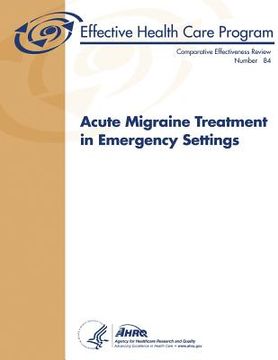Acute Migraine Treatment in Emergency Settings: Comparative Effectiveness Review Number 84 (en Inglés)
Reseña del libro "Acute Migraine Treatment in Emergency Settings: Comparative Effectiveness Review Number 84 (en Inglés)"
Migraine is a chronic neurovascular disorder characterized by dysfunction of the central and peripheral nervous systems and intracranial vasculature. Acute exacerbations of episodic and chronic migraine cause severe and disabling pain that often results in visits to an emergency department (ED), as well as decreased productivity and missed time from work, school, and other activities. Migraine has a negative impact on overall quality of life and is associated with psychiatric and medical comorbidities. In the United States, migraine and related medical issues result in costs of more than $13 billion per year due to lost productivity. Migraine causes acute headaches, which typically last 4 hours to 3 days if untreated. Most individuals with migraine are able to treat their attacks at home; however, this treatment is not always successful. Furthermore, when the initial oral treatment for acute severe headaches fails, subsequent attempts are likely to fail as well. Of Americans with migraine, 7 percent were reported to use an ED or urgent care center for treatment of severe headache within the previous 12 months.7 In the United States, headaches accounted for 2.1 million ED visits annually, 2.2 percent of all ED visits.8 Migraine sufferers who use the ED often report multiple ED visits annually. While headache is a common cause of presentation to the ED, there is substantial practice variability among emergency clinicians. Twenty disparate parenteral agents are used to treat acute migraine in EDs in the United States. Among the agents used are 5-hydroxytryptamine (HT) receptor agonists (e.g., triptans), dopamine receptor antagonists (e.g., phenothiazines, metoclopramide), ergot derivatives (e.g., dihydroergotamine [DHE]), intravenous (IV) nonsteroidal anti-inflammatory drugs (NSAIDs), and opioids. The most common first-line agents for migraine treatment include opioids; however, in more recent research studies, metoclopramide and prochlorperazine, a phenothiazine, appear to be increasingly used. While alternative phenothiazines exist, prochlorperazine is usually preferred due to its efficacy and safety. IV DHE and ketorolac are also used to treat acute migraine. Opioids are often used to treat acute migraine, despite their recognized ability to cause dependence and their association with a higher risk of headache relapse.18 Some physicians use agents sequentially (e.g., metoclopramide followed by ketorolac if patients are not fully recovered following a 30-60-minute assessment period); however, the use of a combination treatment is also popular (e.g., metoclopramide and ketorolac administered simultaneously). The first objective of this Comparative Effectiveness Review (CER) is to assess the effectiveness of various parenteral medications for adult patients with moderate to severe acute migraine who present to an ED for treatment. The second objective is to assess important immediate and short-term side effects of the different interventions. This CER will specifically investigate akathisia associated with metoclopramide and phenothiazines. A third focus is to examine the benefit and risk of using corticosteroids for preventing recurrence of acute migraine that results in a return visit to a physician or ED.

